York University – this is my time
Services (BRONZE)
Client Credits: York University
Susan Webb, Chief Communications & Marketing Officer, Communications & Public Affairs Division
Robin Edmison, Associate Director, Marketing & Creative Services, Communications & Public Affairs
Sarah Bromley, Marketing Manager (2013)
Mamdouh Shoukri, , President & Vice-Chancellor
Agency Credits: ds+p
Doug Robinson, Partner (Chief Creative Officer), ds+p
Mike Welling, Partner (Brand Strategist), ds+p
Kim Hunter, Account Director (2013-14), ds+p
Lara Barcelos, Senior Designer, ds+p
Solly Bulbulia, Senior Designer, ds+p
Jason Buback, Associate Creative Director, Copywriter, ds+p
Rachel Lai, VP, Consumer Insights, ds+p
Rachael Goodman, Account Director (2012-13), ds+p
Zoryana Loboyko, VP Client Service, ds+pDirector, PHD Canada (2013-14)
Matt Devlin, Digital Director, PHD Canada (2013-14)
Beth Mason, Account Director, PHD Canada (2013-14)
Kelly Dutton, President, Gaggi Media Communications (2012-13)
Arden Tucker, Account Director, Gaggi Media Communications (2012-13)
David Hale, CEO & Managing Director, Soshal Group (2013-14)
Bud Williamson, President & Producer, Ninja9 Productions
Ron Baxter-Smith, President, Ron Baxter-Smith Photographer Ltd.
David Fleury, President, Fleury Music
Angela Carroll, Producer, Carroll & Co.
Section I — BASIC INFORMATION
| Business Results Period (Consecutive Months): | September 2012 – January, 2014 |
| Start of Advertising/Communication Effort: | September 2012 |
| Base Period as a Benchmark: | January 2009-August 2012 |
Section II — SITUATION ANALYSIS
a) Overall Assessment
In 2012 York faced a major challenge.
Canada’s 3rd largest university’s reputation was suffering and student applications were declining:
- overall applications were -6.2% vs. an overall market increase of +2.4%, and key competitors U of T (+4.5%) and Ryerson (+7.5%)
- first and second choice were -3.8% and -1.9% respectively vs U of T (+4.5%) and Ryerson (+7.4%). In January prospective undergraduate students have to identify their top three choices (a key indicator of reputation as ‘first choice’ is a reflection of the quality of students.).
Declining applications meant declining undergraduate enrollment, the main driver of operating revenue. Without a dramatic turnaround this scenario seriously threatened programming and other necessary investments.
York’s reputation and applications were suffering in the face of:
- an array of negative publicity in the GTA:
- labour disruptions at the school,
- on-campus protests
- on-campus safety issues
- low share of voice: York had been absent from reputation/recruiting advertising since 2009. AC Nielsen reported York reputational spending of just $285K against $12.74M PSE spend for12 of 21 schools tracked. In contrast Humber College , George Brown , U of T and Ryerson were investing considerably more.
Additionally, following the recession the major community colleges were actively promoting the practical benefits of a college eduction over university, a challenge for York given that half of its 50,000 students are enrolled in Liberal Arts programming.
- a dramatic increase in competitive messaging. During 2010-11, monitored (AC Nielsen, Comscore) post-secondary education (PSE) spending by 12 of 21 Ontario schools totalled over $27M.
- Ryerson’s increasing profile in downtown Toronto meant Ryerson was enjoying a wave of positive press. in reputation rankings Ryerson had positive momentum and was gaining on York.
This plethora of ‘bad news’ was a real problem impacting York.
Reputation is a key driver when prospective students and their parents consider a post-secondary school, and because York wasn’t telling their story via paid media, others were defining their reputation.
Furthermore, the visual identity of York U had become fragmented and the brand was not clearly differentiated from its competitors.
b) Resulting Business Objectives
The key objectives were:
- Drive improvements in perceptions & reputational ranking. Results would be measured via brand tracking as well performance in rankings from publications like Macleans.
- Arrest the decline in applications, particularly first choice appications, by 2014.
- By 2015 drive increases in student applications, particularly first choice.
- A softer objective was to instill a greater sense of pride in York’s students, faculty and staff.
c) Annual Media Budget
$1 – $2 million
d) Geographic Area
Princlpally the Greater Toronto Area, with some across the province and nationally.
Section III — STRATEGIC THINKING
a) Analysis and Insight
York is different from many other universities. It is more of a commuter school than a destination school, meaning the majority of York’s students come from the GTA.
The benefit of this was we could focus our messaging on the GTA market.
York’s student population is also emblematic of the diverse new Canada with a disproportionate number of students (1/3) being first generation Canadians. This means they are also often the first in their families to attend university.
We uncovered the insight that for these kids and their parents a university education was the best way for them to open new doors to a better future and a more successful life.
With our target focused on university, not college, our primary competitors were U of T and Ryerson. Both schools were outspending York, but their messaging wasn’t deemed that efficient or focused.
- U of T led the reputation rankings. Their ‘Boundless’ campaign focused heavily on the accomplishments of their alumni.
- Ryerson was enjoying a high profile building boom, and proximity to the heart of downtown Toronto. Their messaging wasn’t that focused — they were just the cool place to be.
Most PSE campaigns focused on promoting the school, not the ultimate benefit to the student. They focused on the practical, York wanted to be aspirational.
Research also told us students defined success as more than just achievements, jobs or money. It was also about making a positive contribution to the world.
But with job prospects tightening and the cost of post-secondary education rising, their parents were also seeking reassurance of the practicality of their son or daughter’s education.
Against those insights we needed to position York as an excellent way to prepare students to contribute to and thrive in the world.
As a pre-cursor to the development of the campaign ds+p led York through a brand definition exercise engaging a wide range of stakeholders. This identified key York brand truths and insights into our core target (prospective students), leading us to the new positioning of ‘Global thinking. Shaped here.’.
This reflected the quality of education at York, the international recognition of the university and the diversity in the student population.
York’s key advantage to Ryerson was in its diversity (programming, student body) and a rich legacy of innovative programming coupled with with connections to over 280 universities worldwide. In addition it had a rich history of innovation and over 250,000 alumni, some very famous.
We needed to associate York with excellence and leverage points of equity that could be easily recognized.
The Schulich School of Business and Osgoode Hall School of Law were readily associated with excellence but not York. Visually they were often presented in the market with little or no link back to York. York needed to ensure that those areas of excellence were more closely associated with York so that their reputations would halo over the total York University brand.
The Big Idea: ‘This is my time’
Creative zones were explored amongst 468 prospective students and 406 parents in the GTA, each zone grounded in an insight that was then supported by how York delivers on benefits to the student. The zones were evaluated for:
- relevance and appeal of the main message,
- competitive distinctiveness,
- ability to improve York’s image
- likelihood to consider York.
We also tested the reaction to accomplished alumni.
One concept stood out amongst the others:
- 86% rating it as appealing,
- 62% saying it ‘makes you most interested in learning more about York’,
- 68% saying ‘sounds like the university you would want to attend’
- 65% saying ‘is most appealing to you personally’.
These were fabulous results that proved the concept could indeed shift perceptions.
The learning was applied to refine the concept into the ‘This is my time’ campaign. The key desired take-away was ‘York will give me both the excellent academic foundation and the real world experiences I need to channel my passions into action.’.
The multi-dimensional campaign concept was designed to work on several fronts, principally:
- We couldn’t own the past, U of T owned that, but we could own the future through a twist on the conventional testimonial. We featured actual York students sharing their inspired visions of how they help shape the world, at some point in the future.
- Leverage accomplished alumni, the ones currently shaping global thinking as proof of the quality of a York education.
- Capitalize upon accomplished faculty to further reinforce the quality of the education, coupled with proof points like our global reach (a key differentiator) to support York as a wise choice.
b) Communication Strategy
We had to reverse negative momentum in brand perceptions which meant we had to overcome preconceived biases to drive reconsideration of York as a viable choice.
Despite having arguably the best business school in the country, York was perceived as a left-of-centre, socially and politically oriented liberal arts school — not a strongly relevant position in the market.
To overcome preconceived notions about York we needed to surprise our audiences with the breadth of programming at York and the quality of the impact of future and past York grads, and the quality of their faculty in leading global thinking.
Strategically that meant that we would focus on examples that people didn’t readily associate with York.
This meant a greater focus on building the association with Schulich, Osgoode Hall, Glendon College and Lassonde, but also on sciences, health, engineering etc.
Despite limited resources we had several audiences to engage, all in a relevant fashion:
- Prospective grade 11 and 12 students within the GTA. They needed to be inspired and see themselves so they could self-identify. That meant featuring students that reflected the diversity of the GTA, and the diversity of programming.
- Parents of prospective students since they influence 80% of all decisiona about where to attend school. They needed to see their child and their child’s talents succeeding in an environment, but they also needed to be reassured about their ability to leverage that experience into a job. That meant future visions yes, but also reassurance about the success of a York education through accomplished alumni and key proof points.
- Key ‘influencers’ in the business community whose perspective can influence public opinion, and whose support enhances York’s reputaton. They are less emotionally engaged in the category and need more proof points to shift their perceptions.
- The 65,000 York faculty, staff and students who can be powerful brand ambassadors for York, but would often be more hesitant to publicly support because of the stigma associated with the brand. They needed to feel inspired by the campaign and proud of their choice of school and employment. They needed to see themselves and be actively engaged. Internal marketing would be as important as external.
We redefined the brand hierarchy to ensure that areas of excellence and visibility, like Schulich and Osgoode, were visually linked to York. This meant ensuring the faculty/school name was inextricably tied to the York logo.

Section IV — KEY EXECUTIONAL ELEMENTS
a)Media Used
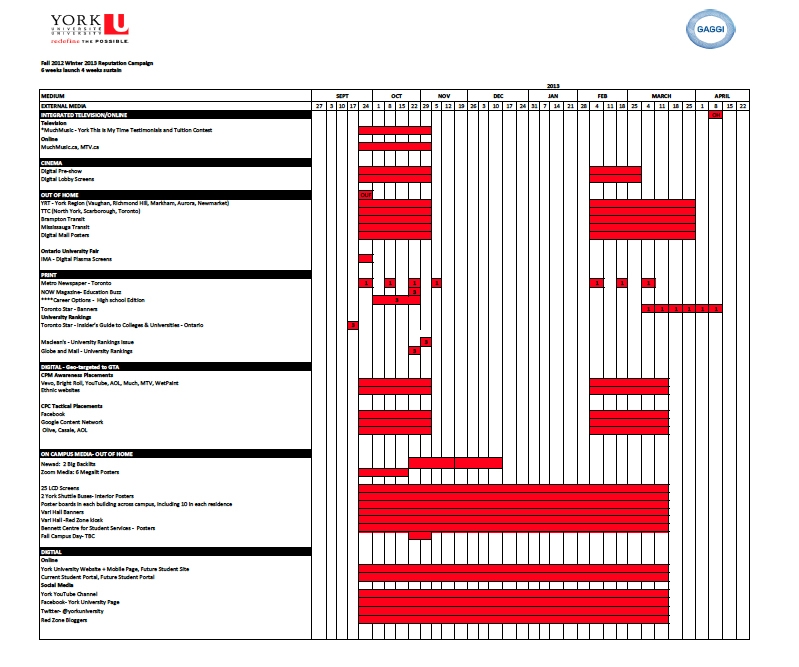
b)Creative Discussion
The creative idea behind ‘This is my time’ was to position York as the catalyst to achieve prospective students’ dreams using a twist on the traditional testimonial. These forward vision student testimonials featured real York students sharing their inspiring dreams about what they hope to achieve in the future as a result of their York education.
The campaign was designed to feature many different students and faculties so that it maximized the appeal by ensuring as many prospective students as possible could self-identify.
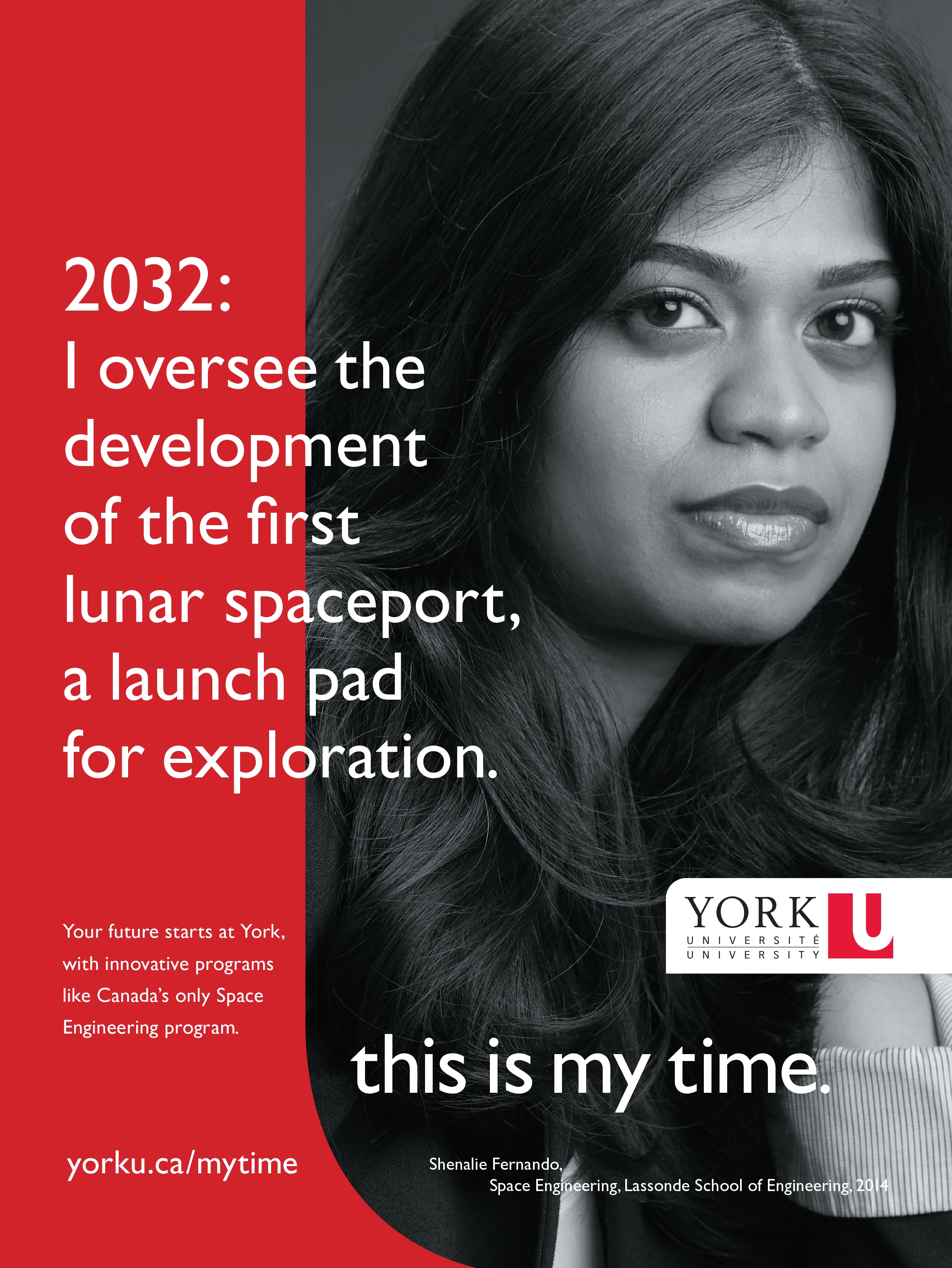
The student executions were complemented with creative featuring leading professors and accomplished alumni to reinforce York’s academic credentials, innovation, influence and the practicality of a York education. All executions featured a powerful, emotive headline and strong supporting body copy.
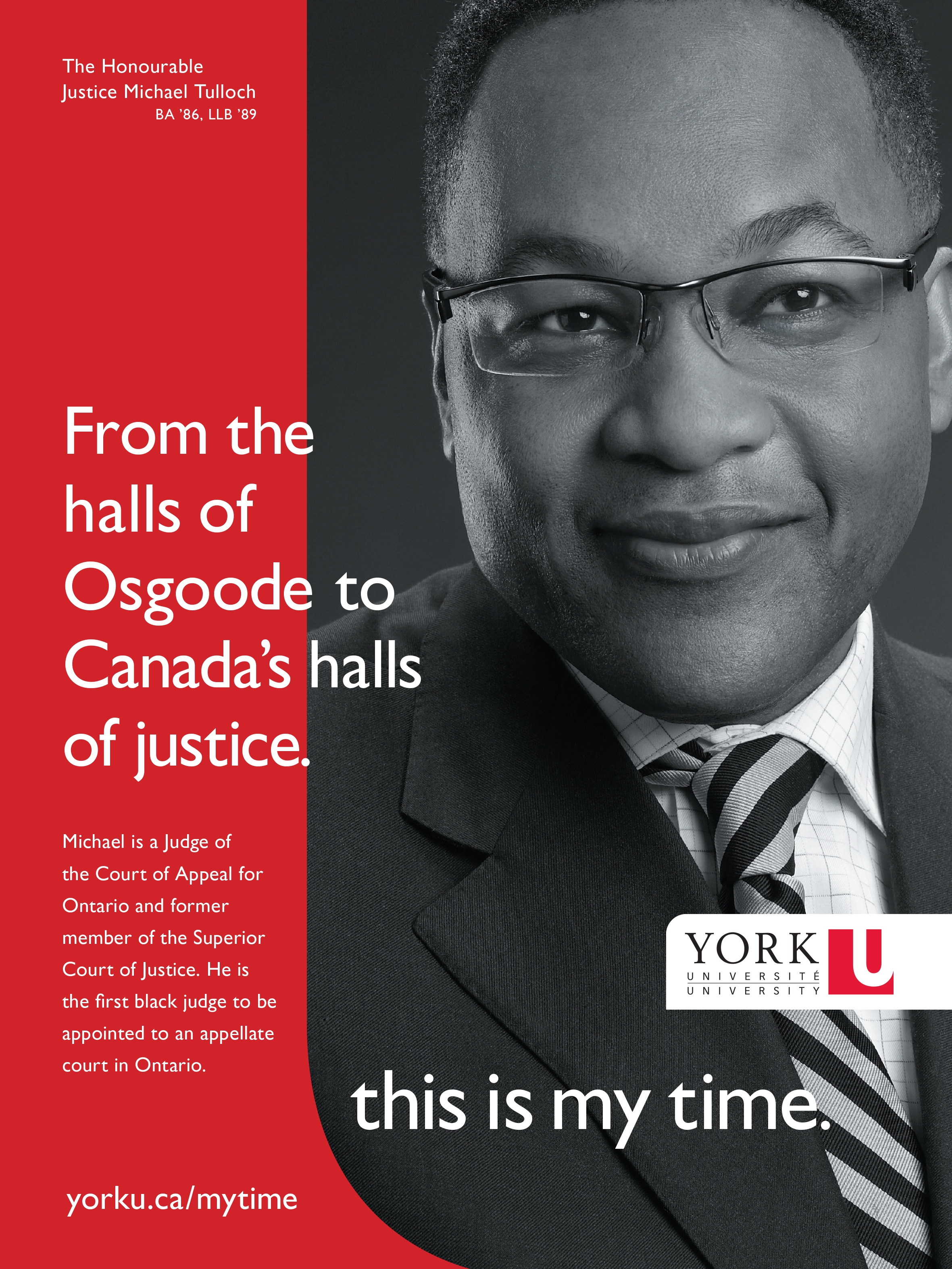
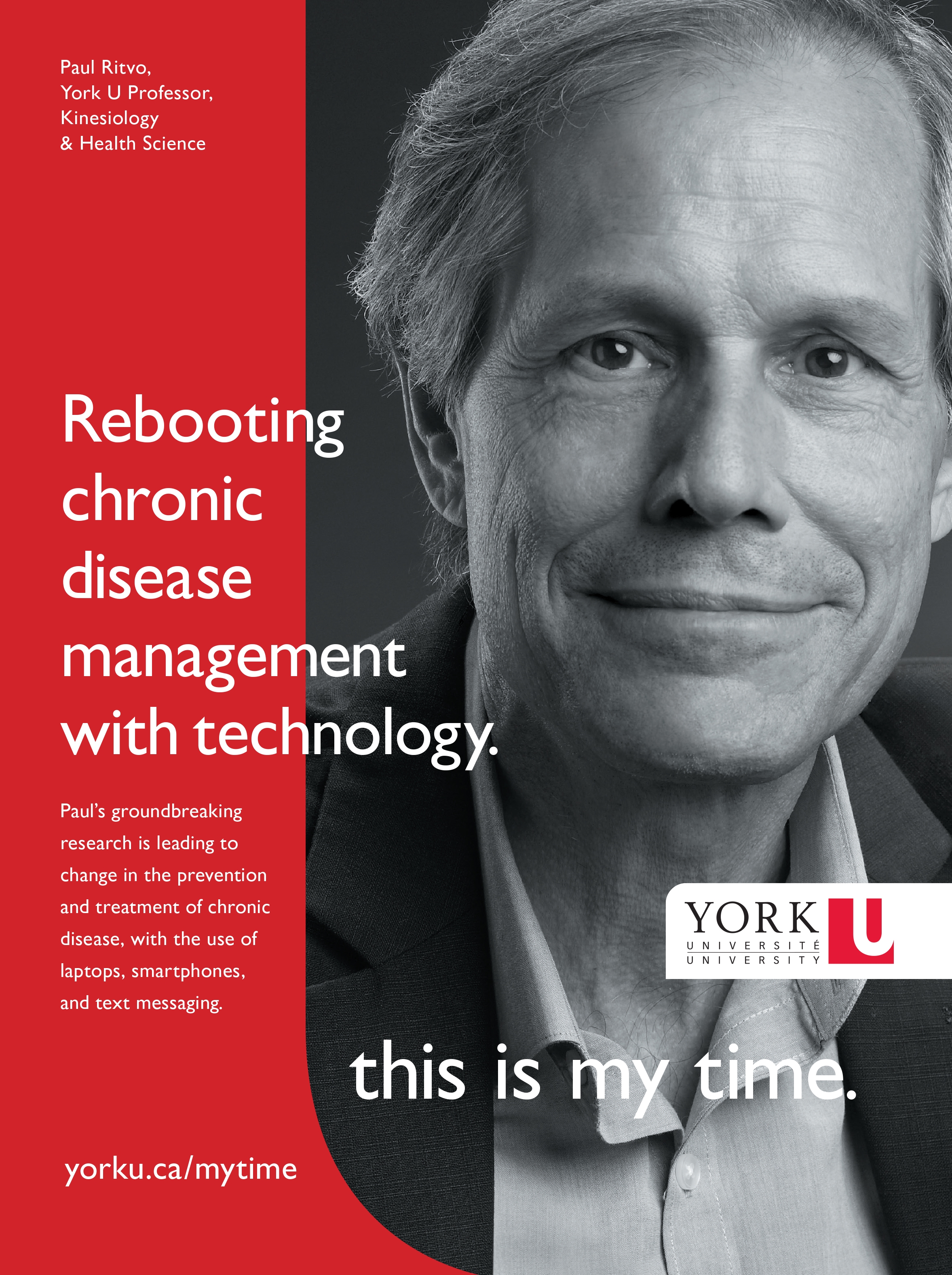
Iconic black and white photography was used against a distinctive York branded template featuring part of the red York logo, and strong York branding to give a smart, sophisticated persona. Real students and real visions, made the creative inspiring. Print was complemented with video used online and in cinemas in the first year, and on TV in the second year. Leveraging a simple, musical soundtrack gave a powerful emotive voice to the campaign.
c)Media Discussion
Media
Since reversing the decline in applications was the #1 metric, spending was focused from mid-Sept to early January when students would be most actively seeking information and discussing their options with their families and friends, with some carry over through the Spring to maintain awareness through the application conversion period. This aligned to the annual Ontario University Fair (OUF) in late September, when many students start to think about university, through to the application deadline date in the second week of January.
If we wanted to position York as being innovative and owning the future, we also needed to ensure we were innovative in bringing the campaign to life. TV & Cinema were key in providing emotional appeal. We needed to make York ‘cool’ so the first year involved a co-promotion with MuchMusic which featured MuchMusic on campus at York. No other university was doing anything like this.
We developed a microsite that served as a ‘vision exchange’ whereby prospective students were exposed to all of the campaign creative (student, faculty, alumni) and could learn more about York, open house dates and submit their vision for a chance to win free tuition. The contest was expanded to engage current York students with a chance to win free tuition. In the second year the contest was enhanced to encourage active sharing via social media.
We worked to reach our respective target audiences during relevant periods and context:
- OUF booth, including a photo booth to have your own ‘this is my time’ photo taken.
- Handbook designs
- Transit and TSAs targeted high schools in the GTA
- Cinema through the Thanksgiving and Christmas holiday periods, key times when families discuss PSE plans.
- Print to target parents (Toronto Star), students (University Guides/Rankings) and influencers (Globe & Mail)
- While colleges were using TV, our competitors were not, so York stood out
- On-campus signage and shuttle bus wraps to reach current students, faculty and staff and visitors to York
- innovative digital applications like SayMedia to leverage video properties

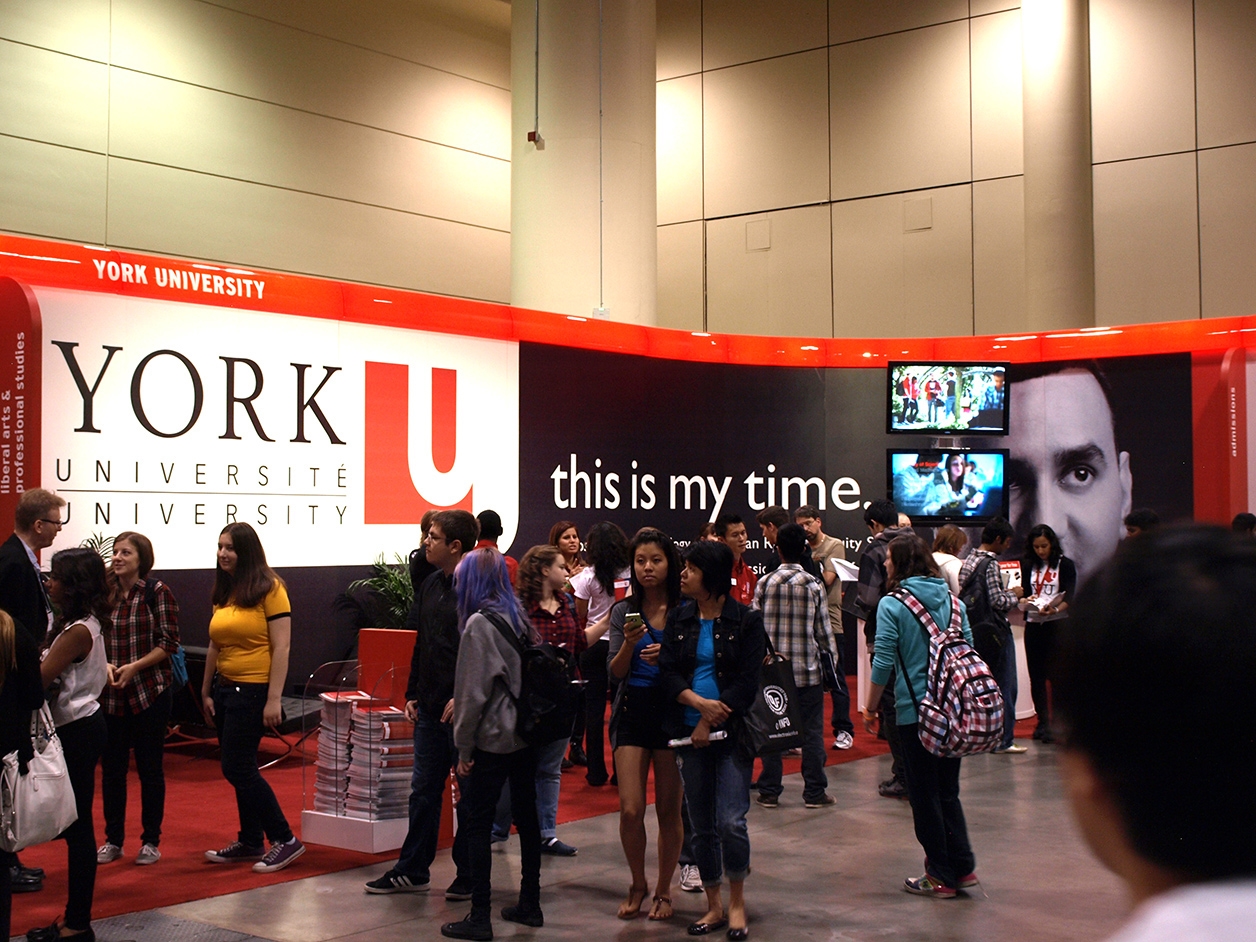

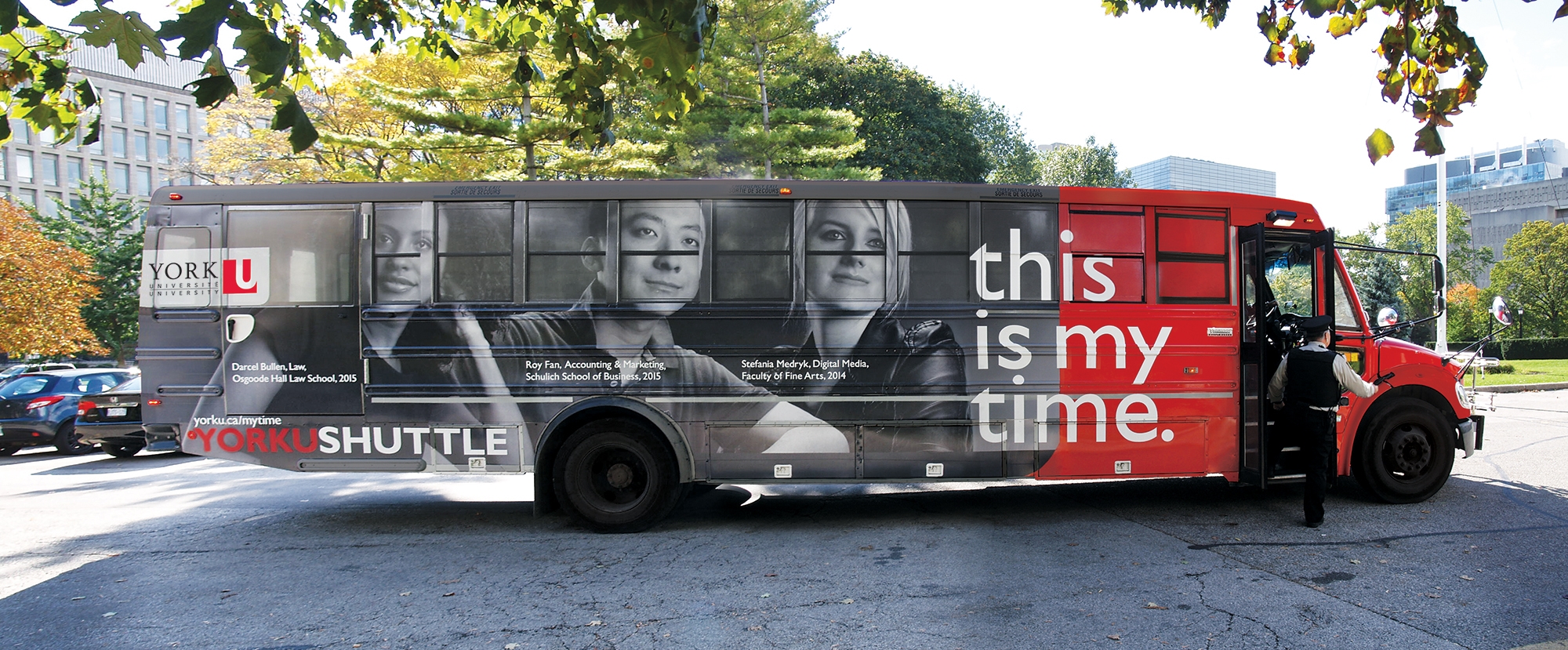
Section V — BUSINESS RESULTS
a) Sales/Share Results
After only 16 months, not only have we arrested their decline in applications, but we’ve increased overall applications, bucking the category trend and outperforming U of T and Ryerson!

- The campaign won gold, silver and bronze at the 2014 North American Council for Advancement & Support of Education awards
- Silver for Best Student Recruitment Initiative at the 2014 Canadian Council for the Advancement of Education awards.
- Successful engagement of current students achieved with 8,540 contest entries, and of future students with 7,616 entries to date
- #yorkumytime was a top-trending twitter hashtag in Toronto in October
- +13.8% Facebook likes from September 2013 to January 2014
- +8.4% Twitter followers September 2013 to January 2014
- 72,444 visits to the MuchMusic York contest page in 2012-2013
- School pride increased: staff are reporting a greater understanding of the York brand proposition and a new sense of pride in their school
- 70% increase in Fall Campus Day
- 306,000 YouTUBE views of our videos. Two videos of our free tuition winner received an additional 15,000 views.
- Over 400,000 website hits
Reputation rankings also improved:
- MacLean’s- changes vs 2012:
- “Reputation Index” +8 spots
- “leaders of tomorrow” +12 spots
- “most innovative” +7 spots
b) Consumption/ Usage Results
c) Other Pertinent Results
d) Return on Investment
Section VI — CAUSE & EFFECT BETWEEN ADVERTISING AND RESULTS
a)General Discussion
Tracking research (The Strategic Counsel, January 2014) shows the advertising is changing opinions/influencing behaviour:
Students:
- 65% of applicants said the ads caused them to consider applying
- Unaided recall of the advertising and where York is identified as the sponsor is high. In all, 39% of 1st choice and 38% of 2nd choice applicants recall the ads and identified York as the sponsor. Among non-applicants the proportion is 18%.
- Aided recall of the York advertising is high with 84% of York applicants 1st choice and 78% of 2nd choice or higher applicants and 69% of non applicants recalling at least one type of ad.
- Responses to the advertising is very positive among York applicants. Among applicants recalling York advertising three-quarters report that the ads encouraged them to find out more about York.
- Two-thirds of applicants report that the ads encouraged them to consider applying to York.
- In terms of perceptions of the quality of undergraduate education at York and perceptions of improvements to York’s reputation, both showied strong gains over 2013.
Parents & Influencers
- Over half of parents saying they are more likely to consider York as a post-secondary option for their child, and 42% of influencers saying they’re more likely to have a favourable impression of York.
- 65% of parents said they were encouraged to find out more about York.
“The campaign is working for York University on many levels. The initial research showed that the campaign had the potential to shift opinions about York and our array of innovative programs, and the tracking results show that it has had a very positive impact. One important element of our University Academic Plan is to grow the share of undergraduate applicants that make York their first choice, and I was delighted to see that our growth in applications have out-paced market growth. I believe the campaign has been a key driver of that success. The campaign has also worked to reignite pride on campus and throughout the York community, and we look forward to its continued success. We are experiencing a transformation on so many fronts. This really is our time. “
Dr. Mamdouh Shoukri, President & Vice-Chancellor, York University
b)Excluding Other Factors
Spending Levels:
The monitored media spend (AC Nielsen, Comscore) for 12 of 21 Ontario universities and colleges for 2013 was over $27M. York working media spend for the campaign was:
Fall-Winter 2012: $1,020,944
Fall-Winter 2013: $2,303,652
Pricing:
Not applicable to this category.
Distribution Changes:
Not applicable to this category.
Unusual Promotional Activity:
Not applicable to this category.
Other Potential Causes:
Many initiatives at York to transform but no other high profile initiatives to drive such an impact.